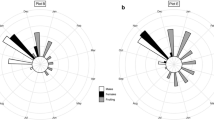Abstract
it has been determined that the sex structure of the population is of great importance for pine adaptation to extreme environmental conditions. As environmental conditions deteriorate, differentiation of populations with respect to sex becomes more apparent, the proportion of trees of mixed type decreases, and the number of male trees increases. A tendency toward correlation between tree habitus, needle and shoot sizes, and the sex structure of population is noted. The prevalence of male trees in populations exposed to increasing stress reflects the rearrangement of such populations aimed at the more efficient use of natural resources.
Similar content being viewed by others
References
Cherepnin, V.L., Izmenchivost' semyan sosny obyknovennoi (Seed Variability in Scotch Pine), Novosibirsk: Nauka, 1980.
Dzhaparidze, L.I., New Data on Sex-Related Differences in Water Content in Plants, Soobshch. Akad. Nauk GruzSSR, 1945, vol. 6, no. 1, pp. 40–42.
Formirovanie i svoistva pereveyannykh pochv (Formation and Properties of Wind-shifted Soils), Orlovskii, N.V., Ed., Moscow: Nauka, 1967.
Ivanov, N.N., On Biochemical Differences between Sexes, Usp. Biol. Khim., 1935, vol. 11, pp. 164–202.
Iroshnikov, A.I., Geographic Cultures of Coniferous Plants in Southern Siberia, in Geograficheskie kul'tury i plantatsii khvoinykh v Sibiri (Geographical Cultures and Plantations of Coniferous Plants in Siberia), Novosibirsk: Nauka, 1978, pp. 4–20.
Jankiewicz, L.S. and Stecki, L.Y., Some Mechanisms Responsible for Differences in Tree Form, in Tree Physiology and Yield Improvement, Cannell, M.G.R. and Last, F.T., Eds., London: Academic, 1976, pp. 157–172.
Mamaev, S.A., The Study of Growth and Development of Scotch Pine in the Context of the Tasks of Forest Seed Growing, Abstract of Cand. Sci. (Biol.) Dissertation, Moscow, Timiryazev Agricultural Academy, 1956.
Mamaev, S.A.,Formy vnutrividovoi izmenchivosti drevesnykh rastenii (na primere sem. Pinaceae na Urale) (Forms of Intraspecific Variation in Tree Plants: An Example of the Family Pinaceae in the Urals), Moscow: Nauka, 1973.
Minina, E.G., Sex Determination and Endogenous Growth Regulators in Some Coniferous Forest Species, in Polovaya reproduktsiya khvoinykh (Sexual Reproduction of Conifers), Novosibirsk: Nauka, 1973, pp. 146–156.
Minina, E.G. and Tret'yakova, I.N., Geotropizm i pol u khvoinykh (Geotropism and Sex in Conifers), Novosibirsk: Nauka, 1983.
Morozov, G.F., Lesovodstvennaya dendrologiya. Otnoshenie drevesnykh porod k svetu. O tipakh nasazhdenii. Konspekt lektsii (Forestry Dendrology. Attitude of Tree Species to Light. On the Types of Tree Stands. A Conspectus of Lectures), St. Petersburg: S.-Peterb. Lesnoi Inst., 1903–1904.
Nekrasova, T.P., Plodonoshenie sosny v Zapadnoi Sibiri (Fruiting of Pine in West Siberia), Novosibirsk: Sib. Otd. Akad. Nauk SSSR, 1960.
Polezhaeva, Z.N. and Savin, E.N., Oblesenie erodirovannykh zemel' (Afforestation of Eroded Lands), Moscow: Lesnaya Promyshlennost', 1974.
Pravdin, L.F., Sexual Dimorphism in Scotch Pine (Pinus sylvestris L.), Tr. Inst. Lesa Akad. Nauk SSSR, 1950, vol. 3, pp. 190–201.
Pravdin, L.F., Sosna obyknovennaya (Scotch Pine), Moscow: Nauka, 1964.
Romanovskii, M.G., Formirovanie urozhaya semyan sosny obyknovennoi (Formation of Seed Yield in Scotch Pine), Moscow: Nauka, 1997.
Serebryakov, I.G., Ekologicheskaya morfologiya rastenii (Ecological Morphology of Plants), Moscow: Vysshaya Shkola, 1962.
Sosna obyknovennaya v Yuzhnoi Sibiri (Scotch Pine in Southern Siberia), Milyutin, L.I., Ed., Krasnoyarsk: Inst. Lesa i Drevesiny, Sib. Otd. Akad. Nauk SSSR, 1988.
Suntsov, A.V., Form Diversity of Scotch Pine in Central Tuva, in Izmenchivost' i introduktsiya drevesnykh rastenii Sibiri (Variations and Introduction of Woody Plants in Siberia), Krasnoyarsk: Inst. Lesa i Drevesiny, Sib. Otd. Akad. Nauk SSSR, 1984, pp. 124–132.
Tkachenko, M.E., Obshchee lesovodstvo (General Forestry), Moscow: Goslesbumizdat, 1952.
Zimmermann, M.H. and Brown, C.L., Trees Structure and Function, New York: Springer, 1971, pp. 125–165.
Author information
Authors and Affiliations
Rights and permissions
About this article
Cite this article
Tikhonova, I.V. Sex Structure of Scotch Pine Populations in the Dry Steppe. Russian Journal of Ecology 34, 370–374 (2003). https://doi.org/10.1023/A:1027304332042
Issue Date:
DOI: https://doi.org/10.1023/A:1027304332042




